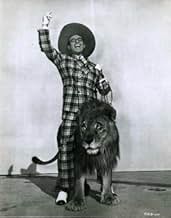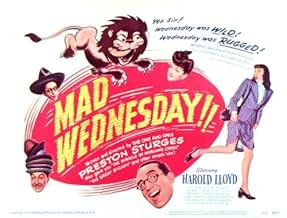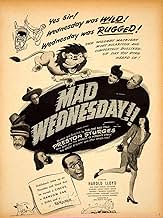IMDb-BEWERTUNG
6,3/10
1807
IHRE BEWERTUNG
Füge eine Handlung in deiner Sprache hinzuHarold is a mild-mannered clerk who dreams about marrying the girl at the desk down the aisle. But then he loses his job, and when he is offered a potent drink at a bar, he goes on a very st... Alles lesenHarold is a mild-mannered clerk who dreams about marrying the girl at the desk down the aisle. But then he loses his job, and when he is offered a potent drink at a bar, he goes on a very strange and funny rampage (with a lion in tow).Harold is a mild-mannered clerk who dreams about marrying the girl at the desk down the aisle. But then he loses his job, and when he is offered a potent drink at a bar, he goes on a very strange and funny rampage (with a lion in tow).
- Auszeichnungen
- 2 Nominierungen insgesamt
Empfohlene Bewertungen
"The Sin of Harold Diddlebock" and "Mad Wednesday" are like two twins who hate each other, so they try to change the way they look. Preston Sturges talked Harold Lloyd into coming back to movies after he had retired. Not only that but Lloyd allowed Sturges to use part of his film "The Freshman" for the opening of the film and to be an investor. Their agreement was that each had the final cut of the film. Lloyds' cut is called "The Sin of Harold Diddlebock". Sturges' is called "Mad Wednesday".
Some material is lost on both cuts and some is added. Both are utterly funny with "Mad Wednesday" being a little crazier. Rudy Vallee is almost lost in "Diddlebock" but a major character in "Wednesday". And though both end with Lloyd and Frances Ramsden (The next Mrs. Sturges) in a horse drawn carriage, the last shot of "Wednesday" has the horse singing to the lovers.
If you are interested in how two comic geniuses could shape the same material into two different pictures, then you must see them both. Silly. Funny. Absolutely must sees.
Some material is lost on both cuts and some is added. Both are utterly funny with "Mad Wednesday" being a little crazier. Rudy Vallee is almost lost in "Diddlebock" but a major character in "Wednesday". And though both end with Lloyd and Frances Ramsden (The next Mrs. Sturges) in a horse drawn carriage, the last shot of "Wednesday" has the horse singing to the lovers.
If you are interested in how two comic geniuses could shape the same material into two different pictures, then you must see them both. Silly. Funny. Absolutely must sees.
Harold Lloyd was one of Hollywood's greatest physical comedians and actors of Buster Keaton and Charlie Chaplin generation. This film marks his final performance but he could have done so much more in film. Regardless, his contributions should not be overlooked. Harold Lloyd plays Harold Dibbledock, a former football players, who ends up at a dead-end job as a clerk for 22 years. His ungrateful boss sends him packing after he fires him for years of service which was more like a prison sentence than a job. He never relived his glory days on the field. When he encounters an old man who seeks a few dollars to play the horses, he begins a new life after he takes a drink. Until then, Harold has never drank alcohol. He awakens up to learn that he's changed and doesn't have a clue about it. Margaret Hamilton plays Flora in a small performance. Anyway, he learns that he's bought a cab with a driver and a horse and a circus. Anyway, the film's best scenes are stolen by Jackie, the lion. It's a good film!
The last laugh of any great clown is interesting, if only for its memento mori value. Laurel & Hardy's last film, UTOPIA, is sadly botched but moments of their grand comedy still flair up, like Marc Antony's final bravery in Shakespeare's Antony & Cleopatra. The grandiose W.C. Fields still holds his own in SONG OF THE OPEN ROAD, even though he was deathly ill with alcohol poisoning. The Marx Brother's LOVE HAPPY is mainly a vehicle for one last pantomime fling for brother Harpo -- and all the more poignant for it. Chaplin's KING IN NEW YORK is a splendid idea -- we chuckle at its conception -- though Chaplin conducts himself like a department store floorwalker more than a comedian. And Harold Lloyd's last movie seems to me to be a nostalgic conspiracy between him and director Sturges, a Last Hurrah to remind movie audiences one last time of the glorious slapstick & pantomime heritage that America was in the process of losing forever as the old clowns faded from the scene and brash lunatics like Martin & Lewis or Bob Hope took over the reins of comedy. Lloyd's film exists in several differently edited versions, but I won't call any of them "butchered", just misunderstood. By the late Forties there weren't any skilled editors around who could quite understand the cadence, the beat, the nearly-balletic timing that a great clown brought to the camera and needed the editor to highlight -- such things as double-takes, long shots of the chase and just stationary shooting when the clown is unfolding a gag. Lloyd produced a novel, a War & Peace, if you will, of vintage gags -- his editors only understood short stories or magazine articles. They grew nervous when the camera lingered on anybody or anything. But great comedy is just that -- lingering. In his final film Lloyd wants to loiter over gags silly and profound. His dawdling is cut short and the truncated comedy that follows seems at times stiff and childish. But before Harold is relegated to the dusty shadows he still pulls off much nonsense that is both genial and brassy -- not a coming attraction, but a dignified retreat back to the Land of Belly Laughs. Anyone grounded in American cinematic comedy feels abit like one of the children in the story of the Pied Piper; we wish we could go with him back into that wonderful, magical, mountain.
An interesting if ultimately unsuccessful combination of two clashing comedy styles (overseen by humorless mogul Howard Hughes no less), this film turned out to be Harold Lloyd's swan-song - and, as such, it ended on a somewhat positive note (even though the film was made during Sturges' period of decline).
It opens with a reprise of the climactic football game from one of Lloyd's greatest successes, THE FRESHMAN (1925), eventually bringing that same character (albeit renamed!) up to date. Still, in the end, the film is more Sturges than Lloyd: even if the star plays one of his trademark roles of a patsy (though not without the occasional display of ingenuity), there is little of the star's characteristic slapstick here. Instead, the comedy is in Sturges' typical frantic (and, mainly, dialogue-driven) style - with which Lloyd isn't entirely comfortable; the film also features Sturges' stock company of character players in full swing. That said, it's climaxed by yet another of the star comedian's thrilling set-pieces which finds him overhanging from a building-ledge - hampered this time around by a myopic Jimmy Conlin and an understandably disgruntled circus lion!
While a disappointing whole (it was re-issued in 1950 in a shortened version renamed MAD Wednesday), the film does contain a number of undeniable gems: his romantic attachment to every female member of one particular family (all of whom happen to work for the same firm over a 20-year period); his first encounter with Conlin, with the two of them exchanging wise sayings (the optimistic Lloyd had kept a handful nailed to the wall behind him at his former workplace) in order to explain their current dejected state-of-mind; and, best of all, the unforgettable scene in which Lloyd takes his first alcoholic beverage (an impromptu concoction by bartender Edgar Kennedy and which he names "The Diddlebock") that invariably provokes an unexpected yet hilarious reaction.
It opens with a reprise of the climactic football game from one of Lloyd's greatest successes, THE FRESHMAN (1925), eventually bringing that same character (albeit renamed!) up to date. Still, in the end, the film is more Sturges than Lloyd: even if the star plays one of his trademark roles of a patsy (though not without the occasional display of ingenuity), there is little of the star's characteristic slapstick here. Instead, the comedy is in Sturges' typical frantic (and, mainly, dialogue-driven) style - with which Lloyd isn't entirely comfortable; the film also features Sturges' stock company of character players in full swing. That said, it's climaxed by yet another of the star comedian's thrilling set-pieces which finds him overhanging from a building-ledge - hampered this time around by a myopic Jimmy Conlin and an understandably disgruntled circus lion!
While a disappointing whole (it was re-issued in 1950 in a shortened version renamed MAD Wednesday), the film does contain a number of undeniable gems: his romantic attachment to every female member of one particular family (all of whom happen to work for the same firm over a 20-year period); his first encounter with Conlin, with the two of them exchanging wise sayings (the optimistic Lloyd had kept a handful nailed to the wall behind him at his former workplace) in order to explain their current dejected state-of-mind; and, best of all, the unforgettable scene in which Lloyd takes his first alcoholic beverage (an impromptu concoction by bartender Edgar Kennedy and which he names "The Diddlebock") that invariably provokes an unexpected yet hilarious reaction.
This film drags in some parts, and Lloyd I think puts off some modern viewers. The first time I watched it I thought it was the film equivalent of seeing Ali vs. Andre the Giant. But Sturges' brilliance is in here, and the degree to which it is derived from Lloyd is paid homage to in a wonderful, dark, surreal way. How can you not love a film that starts with the last moments of Lloyd's The Freshman and then shows the hero turned into a mail room stooge who gets buried by the corporate system? The ending is wonderfully hypnotic, happy? Well as is always the case, the poor down trodden guy figures out how to operate the machine just enough to produce his own deus ex machina. Sturges and Lloyd look more brilliant and visionary than ever from the vantage point of post-Enron, MCI, etc.
Wusstest du schon
- WissenswertesDuring the scene where Harold Lloyd's character meets Jackie the lion, on the first take when Lloyd pets Jackie, the lion actually bit him on his right hand. However, he was not injured because the lion's teeth scraped against his two prosthetic fingers (Lloyd had lost most of his right hand in an on-set accident in 1919). After that, he refused to pet the lion ever again on- or off-screen, and in the second take, which was used for the film, his terrified squirming over the lion standing next to him is genuine.
- PatzerThe story takes place in New York. It is odd to see Los Angeles City Hall in the background of the final shot.
- Crazy Credits"... and for the first time a young girl called Frances Ramsden playing the youngest Miss Otis"
- Alternative VersionenOriginally released at 90 minutes; was then re-edited and re-released in a shorter 79-minutes version under the title "Mad Wednesday" in 1950.
- VerbindungenEdited from Harold Lloyd, der Sportstudent (1925)
- SoundtracksAmerica, the Beautiful
(uncredited)
Music by Samuel A. Ward
Played during the presidential calendar montage
Top-Auswahl
Melde dich zum Bewerten an und greife auf die Watchlist für personalisierte Empfehlungen zu.
- How long is The Sin of Harold Diddlebock?Powered by Alexa
Details
- Erscheinungsdatum
- Herkunftsland
- Sprache
- Auch bekannt als
- The Sin of Harold Diddlebock
- Drehorte
- Memorial Stadium - Stadium Rim Way, Berkeley, Kalifornien, USA(football scenes edited from The Freshman)
- Produktionsfirma
- Weitere beteiligte Unternehmen bei IMDbPro anzeigen
Box Office
- Budget
- 1.712.959 $ (geschätzt)
- Laufzeit1 Stunde 29 Minuten
- Farbe
- Seitenverhältnis
- 1.37 : 1
Zu dieser Seite beitragen
Bearbeitung vorschlagen oder fehlenden Inhalt hinzufügen

Oberste Lücke
By what name was Verrückter Mittwoch (1947) officially released in Canada in English?
Antwort





































